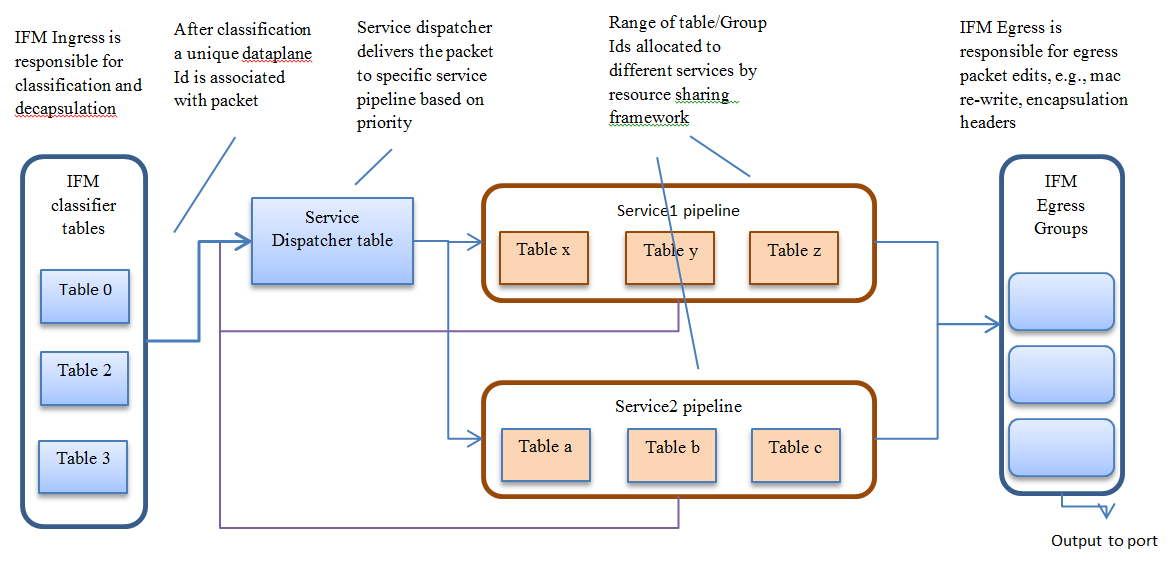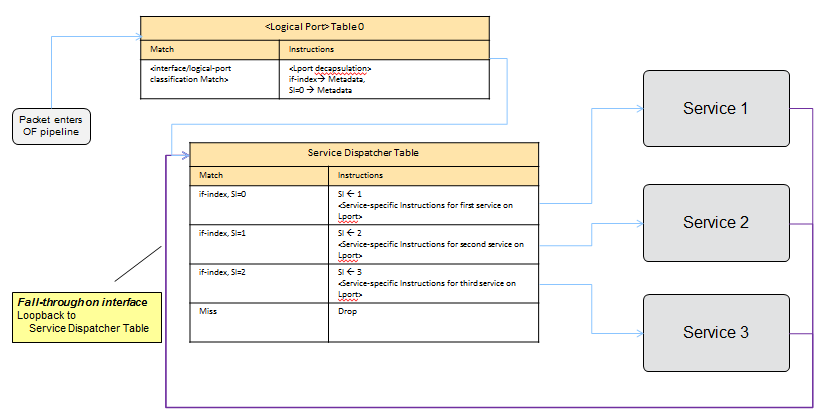Contents
Genius Services
Genius provides components and framework for application co-existence. Following diagram gives an overview of how multiple applications/service based on genius components, can work together.
Genius addresses app co-existence issue based on following principles –
- Different applications use isolated set of openflow resources (tables, groups etc.)
- Achieved using Resource Sharing/Management framework
- Traffic ingress and egress is handled by a common entity serving multiple applications
- Achieved using Interface Manager/ Overlay Tunnel Manager
Interface Management Service
Genius Interface Manager (IFM) provides following main services --
- Ingress Classification & decapsulation
- Service Bindings
- Egress encapsulation
Interface Classification & decapsulation
Interface Manager allows creation of different granular logical ports/ interfaces for different type of network connections and logical ports, e.g. VLAN ports (classified with in-port+VLAN tag), tunnel (VxLAN & GRE) interfaces classified with ([DPN-id]+[in-port]+[vlan]+local-ip+ remote-ip).
Interface Manager provides Yang based API for creation/configuration of different type of interfaces. Each interface is created with a unique interface-name (e.g. UUID of a neutron port) and its classification parameters. Interface configuration also contains a ‘parent-ref’ parameter which defines the parent port/interface which feeds to the child interface. This way a hierarchy of interfaces can be created. IFM classification tables in data-plane also form similar hierarchy.
Interface Manager Operations
When the parent (openflow) port appears on the south-bound interface, Interface Manager accordingly programs corresponding IFM classifier tables and groups.
When a packet hits table 0, IFM classification rules in table 0 removes the encapsulation/tags and direct packets to appropriate next level of classification table. Once the packet is classified belonging to a particular Interface, corresponding data-plane-id is associated with the packet and the packet is sent to the service dispatcher table.
Service dispatcher table, depending upon the services bind to the interface, apply service specific parameters to the packet and dispatches the packet to appropriate service pipeline. If the packet is not consumed (either dropped or sent out) by the particular service, the service pipeline must send(resubmit) the packet back to the dispatcher table for other services for further processing.
Metadata usage
First 24 bits of metadata is reserved by Interface Manager to carry the 21 bit data-plane-id (if-index) along with 3 bits service-index. Applications/ services must preserve these bits for use of interface manger when the packet is sent back to dispatcher table. If a particular service is sure of consuming the packet and packet is not required to be sent back to dispatcher table, in that case the service is allowed to make use of full 64 bits of the metadata.
Interfaces Data Model
Yang Data Model odl-interface.yang contains the interface configuration data-model.
An interface is created at MD-SAL Data Node Path /config/if:interfaces/interface, with following attributes -
Common attributes
- name -- Unique Interface name, can be any unique string (e.g., UUID string).
- type -- interface type, currently supported iana-if-type:l2vlan and iana-if-type:tunnel
- enabled -- Admin Status, possible values 'true' or 'false'
parent-refs : used to specify references to parent interface/port feeding to this interface
- datapath-node-identifier -- Identifier for a fixed/physical dataplane node, can be physical switch identifier
- parent-interface -- can be a physical switch port (in conjunction of above), virtual switch port (e.g., neutron port) or another interface
- list node-identifier -- Identifier of the dependant underlying configuration protocol
- topology-id -- can be ovsdb configuration protocol
- node-id -- can be hwvtep node-id
Type specific attributes
- when type = l2vlan
- vlan-id -- VLAN id for trunk-member l2vlan interfaces
- l2vlan-mode -- Currently supported ones are 'transparent', 'trunk' or 'trunk-member'
- when type = stacked_vlan (Not supported yet)
- stacked-vlan-id -- VLAN-Id for additional/second VLAN tag
- when type = tunnel
- tunnel-interface-type -- Tunnel type, currently supported ones are tunnel-type-vxlan, tunnel-type-gre or tunnel-type-mpls-over-gre
- tunnel-source -- tunnel source IP address
- tunnel-destination -- tunnel destination IP address
- tunnel-gateway -- gateway IP address
- monitor-enabled -- Tunnel monitoring enable control
- monitor-interval -- Tunnel monitoring interval in millisiconds
- when type = mpls (Not supported yet)
- list labelStack -- list of lables
- num-labels -- number of lables configured
Supported REST calls are GET, PUT, DELETE, POST
Creating L2 port interfaces
A normal L2 port (e.g. Neutron tap port) interface is created as an 'l2vlan' interface in 'transparent' mode. This type of interfce classifies packets passing through a particular L2 (OpenFlow) port. The base openflow port for this interface is configured port is interface can pass any L2 packet. In dataplane Packets for this interface are classified by matching of-port-id assigned to the port (as specified in parent-interface).
URL: /restconf/config/ietf-interfaces:interfaces
Sample JSON data
"interfaces": {
"interface": [
{
"name": "4158408c-942b-487c-9a03-0b603c39d3dd",
"type": "iana-if-type:l2vlan", <--- interface type 'l2vlan' for normal L2 port
"odl-interface:l2vlan-mode": "transparent", <--- 'transparent' VLAN port mode allows any (tagged, untagged) ethernet packet
"odl-interface:parent-interface": "tap4158408c-94", <--- port-name as it appears on southbound interface
"enabled": true
}
]
}
Creating VLAN interfaces
A VLAN interface is created as a 'l2vlan' interface in 'trunk-member' mode, by configuring a VLAN-Id and a particular L2 (vlan trunk) interface. Parent VLAN trunk interface is created in the same way as the 'transparent' interface as specified above. A 'trunk-member' interface defines a flow on a particular L2 port and having a particular VLAN tag. On ingress, after classification the VLAN tag is popped out and corresponding unique dataplane-id is associated with the packet, before delivering the packet to service processing. When a service module delivers the packet to this interface for egress, it pushes corresponding VLAN tag and sends the packet out of the parent L2 port.
URL: /restconf/config/ietf-interfaces:interfaces
Sample JSON data
"interfaces": {
"interface": [
{
"name": "4158408c-942b-487c-9a03-0b603c39d3dd:100",
"type": "iana-if-type:l2vlan",
"odl-interface:l2vlan-mode": "trunk-member", <--- for 'trunk-member', flow is classified with particular vlan-id on an l2 port
"odl-interface:parent-interface": "4158408c-942b-487c-9a03-0b603c39d3dd", <--- Parent 'trunk' iterface name
"odl-interface:vlan-id": "100",
"enabled": true
}
]
}
Creating Overlay Tunnel Interfaces
An overlay tunnel interface is created with type 'tunnel' and particular 'tunnel-interface-type'. Tunnel interfaces are created on a particular DPN with a pair of (local, remote) IP addresses. Currently supported tunnel interface types are VxLAN, GRE and MPLSoverGRE. overlay tunnel interfaces are based on tunnel interafces provided by OVS. Some of these interfaces are not yet available with standard OVS versions. However, there are OVS patches available add specific tunnel interface implementation in OVS. Following are tunnel types for which specific patches are available -
1. VxLAN GPE interafce - following link provides information on how to add VxLAN GPE patch to OVS -
URL: /restconf/config/ietf-interfaces:interfaces
Sample JSON data
"interfaces": {
"interface": [
{
"name": "MGRE_TUNNEL:1",
"type": "iana-if-type:tunnel",
"odl-interface:tunnel-interface-type": "odl-interface:tunnel-type-mpls-over-gre",
"odl-interface:datapath-node-identifier": 156613701272907,
"odl-interface:tunnel-source": "11.0.0.43",
"odl-interface:tunnel-destination": "11.0.0.66",
"odl-interface:monitor-enabled": false,
"odl-interface:monitor-interval": 10000,
"enabled": true
}
]
}
Services Binding
After creation of interfaces, different applications can bind services to it. Different services can bind to interfaces on ingress at the packet pipeline ingress as well as at the pipeline egress, before sending the packet out to particular port/interface. To bind a service to an Interface, applications will use a Yang based service binding API provided by interface manager. Following are the service binding parameters –
[[File:interface_hierarchy.png]| align:right]
- Service-Priority
- Service-mode(ingress/egress)
- Service-Name
- Service-Info
- (for service-type openflow-based)
- Flow-priority
- Instruction-list
Service priority parameter is used to define the order in which the packet will be delivered to different services bind to the particular interface. Service priorities must be agreed upon by the participating applications to avoid conflict.
Depending upon the service-mode parameter service is applied to interface ingress on interface egress.
When a service is bind to an interface, Interface Manager programs the service dispatcher table with a rule to match on the interface data-plane-id and the service-index (based on priority) and the instruction-set provided by the service/application. Every time when the packet leaves the dispatcher table the service-index (in metadata) is incremented to match the next service rule when the packet is resubmitted back to dispatcher table. if the service-mode is ingress, ingress dispatcher is programmed or else if the service-mode-egress is configured egress-dispatcher table is programmed.
Binding services on interface
Yang Data Model odl-interface-service-bindings.yang contains the service binding configuration daatmodel.
An application can bind services to a particular interface by configuring MD-SAL data node at path /config/interface-service-binding. Binding services on interface allows particular service to pull traffic arriving on that interafce depending upon the a service priority. Service modules can specify openflow-rules to be applied on the packet belonging to the inetrface. Usually these rules include sending the packet to specific service table/pipeline. Service modules are responsible for sending the packet back (if not consumed) to service dispatcher table, for next service to process the packet.
URL:/restconf/config/interface-service-bindings:service-bindings/
Sample JSON data
"service-bindings": {
"services-info": [
{
"interface-name": "4152de47-29eb-4e95-8727-2939ac03ef84",
"bound-services": [
{
"service-name": "ELAN",
"service-type": "interface-service-bindings:service-type-flow-based"
"service-priority": 3,
"flow-priority": 5,
"flow-cookie": 134479872,
"instruction": [
{
"order": 2,
"go-to-table": {
"table_id": 50
}
},
{
"order": 1,
"write-metadata": {
"metadata": 83953188864,
"metadata-mask": 1099494850560
}
}
],
},
{
"service-name": "L3VPN",
"service-type": "interface-service-bindings:service-type-flow-based"
"service-priority": 2,
"flow-priority": 10,
"flow-cookie": 134217729,
"instruction": [
{
"order": 2,
"go-to-table": {
"table_id": 21
}
},
{
"order": 1,
"write-metadata": {
"metadata": 100,
"metadata-mask": 4294967295
}
}
],
}
]
}
]
}

